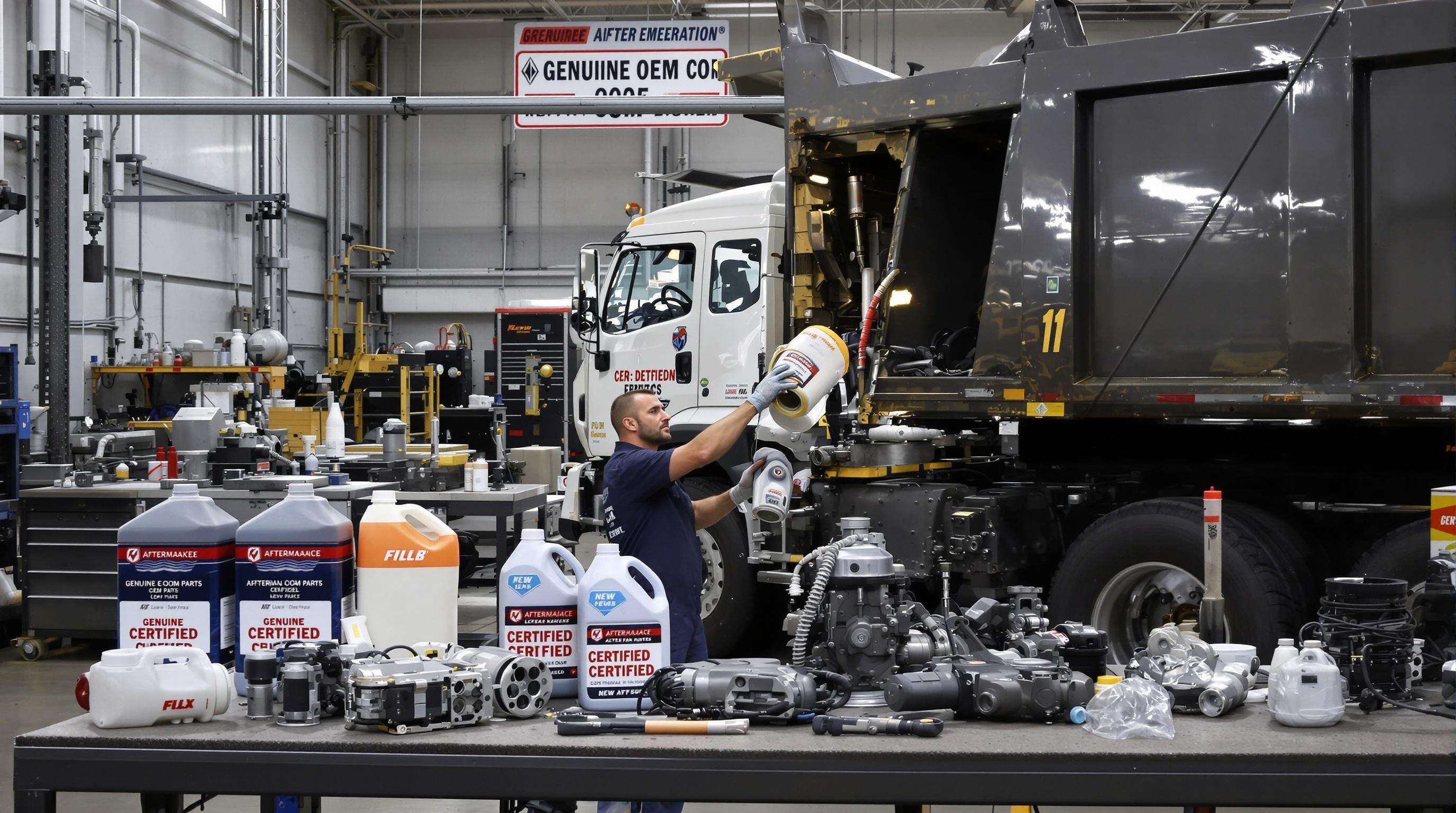24-D10, Building 3, Aosheng Building, Shunhua Road Street, Jinan, Shandong, China +86 13953140536 [email protected]
Switching to preventive maintenance completely changes how fleet managers handle their vehicles instead of waiting for something to break down first. When companies follow manufacturer recommendations for regular checkups and replace parts according to actual usage hours rather than just when things start acting up, they cut down on unexpected downtime dramatically. The focus is especially on parts that wear out fast in dump trucks like those big hydraulic cylinders and all the stress points where the truck actually carries weight. According to data gathered last year from various construction site operators, crews who stuck with planned maintenance schedules saw around two thirds fewer problems with their hydraulic systems than others who only fixed things after they broke. That kind of difference makes a huge impact on project timelines and bottom line costs.
Fleets conducting biweekly inspections achieve 12% higher monthly utilization rates. Monitoring engine hours and load cycles allows mechanics to replace components like transmission filters and brake pads before wear impacts performance. This prevents cascading failures, a leading cause of extended downtime and lost productivity.
One mining company in North America decided to try something different with their big fleet of 40 ton dump trucks. They started using sensors throughout the vehicles and combined regular oil checks with data from the engines themselves. This helped them figure out when it was actually time to rebuild those powertrains instead of following generic schedules. Looking back over eight years worth of operations, these trucks ran for around 98 thousand hours on average. That's pretty impressive considering most similar operations only get about 70 thousand before needing major work. The bottom line? Maintenance expenses went down by roughly 22 percent each year because there were far fewer breakdowns requiring urgent fixes. Money saved on unexpected repairs meant they could hold off replacing equipment longer too, which ultimately made better financial sense for the whole operation.
Preventive maintenance delivers strong ROI by replacing costly overhauls with routine service. For example, a $150 oil change avoids a potential $15,000 engine rebuild. Heavy-equipment operators report a 5:1 savings ratio when comparing scheduled maintenance to breakdown-related expenses. Key cost-saving areas include:
These predictable costs allow fleets to plan for lifecycle extensions instead of emergency repairs.
When doing routine checks, there are several key spots to look at every day. First up, check tires thoroughly including their pressure, any visible cuts, and how much tread remains. Don't forget to test how responsive the brakes feel, then glance at the engine oil level and coolant reservoirs. The hydraulic fluids need inspection too, along with all the lights on the vehicle. Hydraulic cylinders deserve extra scrutiny since bent rods or inconsistent extensions often mean bigger problems are brewing. Mining operations have found something interesting through experience: fleets that make it standard practice to check tire pressure daily see about 28 percent fewer tire failures compared to those that don't. That kind of difference can save money and downtime in tough working conditions where equipment reliability is absolutely essential.
Digital checklists reduce inspection oversights by 47% compared to paper-based systems (Construction Equipment Management Report 2024). Modern fleet software uses customizable templates to guide technicians through 12–15 high-impact checks per cycle, including alternator belts and suspension bushings. This standardization creates auditable records that support warranty claims and regulatory compliance.
Checking hydraulic reservoirs regularly for fluid levels and quality makes good sense since when the fluid starts turning colors it usually means something bad has gotten into the system. Many shops now put in some UV dye during their regular maintenance checks. This lets techs spot those tiny leaks with handheld black lights long before they become major problems. Waste management companies have seen real savings from this approach. One fleet reported saving around $15k-$20k annually per truck on hydraulic repairs alone after implementing the UV dye technique across their entire operation.
Effective training reduces premature wear by teaching best practices like gradual hydraulic engagement and optimal load distribution. Operators trained in pre-shift inspections identify issues like uneven tire pressure—key contributors to drivetrain stress—58% faster than untrained peers. Modern programs emphasize:
These practices reduce annual repair costs by 19% across 23 quarrying operations, according to aggregated fleet data.
Operators who log diagnostic data during shifts enable predictive systems to detect anomalies up to 34% earlier. Consistent recording of hydraulic temperatures, for instance, allows AI platforms to flag seal degradation before leaks occur. Fleets that combine telematics training with incentive programs achieve 41% higher compliance in daily inspection reporting.
| Training Metric | Maintenance Cost Reduction |
|---|---|
| Hydraulic system best practices | 22% |
| Proper gear-shifting frequency | 17% |
| Idle-time management | 14% |
Data from a 2025 material handling study shows that fleets investing 15+ annual training hours per operator extend service intervals on critical components by 28% compared to industry averages.

Fleet management software these days keeps tabs on dump trucks' condition using real-time diagnostics plus automated scheduling features. These platforms look at how engines are performing, check hydraulic pressures, and even monitor tire wear so they know when maintenance needs doing. Field tests showed something pretty impressive too—companies saw their unexpected downtime drop by around 32% according to Construction Tech Journal from last year. Instead of sticking to rigid calendar schedules for services, this approach matches maintenance needs with what actually happens out there on the road. The result? Parts tend to last longer before needing replacement, and operators stay within those manufacturer recommendations without extra hassle.
The IoT sensors can spot problems anywhere from 8 to 12 hours ahead of time in almost nine out of ten situations where something might go wrong. According to a recent report from the World Bank looking at infrastructure issues back in 2023, trucking companies that started checking their transmission systems with vibration sensors and heat cameras saw repair bills drop by around 15 percent and had roughly 22 percent fewer breakdowns along roadsides. What's really interesting is how these machine learning algorithms work behind the scenes. They basically compare what's happening right now with all the past data we've collected over time. This helps mechanics know when parts like brake linings are getting thin or when there might be a leaky valve long before it becomes an emergency situation during regular maintenance checks.
Centralized platforms monitor over 40 performance parameters across dump truck fleets, including coolant pH and driveline torque variances. Anomalies trigger tiered alerts:
| Parameter | Threshold | Action Triggered |
|---|---|---|
| Engine Oil Pressure | < 25 PSI | Immediate shutdown protocol |
| Suspension Stress | 15% above baseline | Next-shift inspection required |
| Exhaust Temperature | 10% sustained spike | Clean DPF filter within 48 hrs |
This system reduces catastrophic engine failures by 67% in quarry operations (Heavy Equipment Quarterly 2023).
Even though there are clear advantages, around 58 percent of mid-sized fleets consisting of between 10 and 50 trucks continue using old-fashioned paper logs rather than adopting predictive maintenance technologies. This creates a real problem where each truck ends up costing roughly $18,500 extra every year for repairs that could have been avoided according to the Fleet Efficiency Report from 2023. Why does this happen? Many fleet managers see these digital tools as complicated to set up and run, plus they often don't have enough people who know how to read through all that data effectively. Fortunately, newer systems are starting to change things. These modular platforms come with much easier-to-understand dashboards and smart features that automatically highlight which tasks need attention first, making it simpler for smaller operations to get onboard with modern maintenance practices.

OEM parts are made according to strict specs, which cuts down on contamination problems inside hydraulic systems by about 63 percent when compared with those cheaper aftermarket options, according to last year's Equipment Management Report. The right type of certified fluid keeps its thickness even when things get really hot or loaded up heavy, so pumps and valves don't break down early. What happens with noncompliant oil? Well, it breaks down around three times quicker during those constant start-stop cycles we see in many operations. And that means big money losses too, roughly speaking somewhere near seven thousand five hundred dollars' worth of unnecessary fixes for each truck annually.
In a recent look at 1200 dump trucks operating across various terrains, researchers noticed something interesting. Original equipment manufacturer parts actually held up much better in tough spots like mines, failing only about 62% less frequently compared to those cheaper alternatives. Meanwhile, those aftermarket bits were responsible for roughly 38% more unexpected breakdowns down the road. Sure, buying genuine parts might set companies back around 15 to 20 percent initially, but these components tend to stick around nearly 3.5 times longer when exposed to all that grit and dust, based on what most maintenance folks track regularly. Most notably, we see these big differences showing up in areas that really matter for safety and operation, particularly around things like keeping engines cool and maintaining proper brake function.
Fleets that stick with original equipment manufacturer filters, fluids, and wear parts tend to save around 22 percent on total ownership costs across ten years of operation. According to research from Ponemon back in 2023, cheap filters account for nearly half all engine rebuilds in those big dump trucks, and these problems usually snowball into bigger issues down the road. The real money saver comes when companies follow proper replacement schedules based on OEM guidelines. Genuine parts work together so well that maintenance becomes much more predictable. Heavy-duty equipment lasts anywhere between eight to twelve extra years when maintained properly this way, which makes a huge difference in long-term expenses for any serious fleet operator.
Preventive maintenance involves regular inspections and servicing of dump trucks based on manufacturer recommendations and usage hours to prevent unexpected breakdowns.
Proper training teaches best practices like gradual hydraulic engagement and optimal load distribution, reducing premature wear and maintenance costs.
Genuine OEM parts reduce contamination and wear in hydraulic systems, making them last longer and saving money on unnecessary repairs.